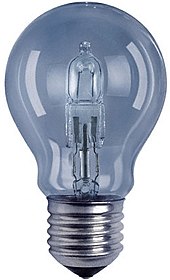



Various governments have passed legislation to phase out manufacturing or importation of incandescent light bulbs for general lighting in favor of more energy-efficient alternatives. The regulations are generally based on efficiency, rather than use of incandescent technology.
Brazil and Venezuela started the phase-out in 2005,[citation needed] and the European Union, Switzerland,[1] and Australia[2] began to phase them out in 2009.[3] Likewise, other nations are implementing new energy standards or have scheduled phase-outs: Argentina,[4] and Russia in 2012, and Canada,[5] Mexico,[6] Malaysia,[7] and South Korea in 2014.[8] A ban covering most incandescent bulbs in the United States took effect in 2023.[9]
Objections to replacement of incandescent lamps for general lighting mainly include the higher purchasing expense of alternative light bulbs. To mitigate the cost effects of these concerns, various programs have been put into place, ranging from subsidies for lamps, to improved standards for measurement of performance and for labeling of products. Manufacturers developed fluorescent lamps with reduced mercury content compared to original designs, and recycling programs are intended to prevent mercury release. New lamp types offer improved starting characteristics, and dimmable types are available.
- ^ Jäggi, Walter (17 October 2008). "Grosses Lichterlöschen für die Glühbirnen". Tages-Anzeiger (in German). Retrieved 8 January 2014.
- ^ "Energy Efficiency – Lighting". Department of the Environment, Water, Heritage and the Arts. Archived from the original on 11 June 2009. Retrieved 8 January 2014.
- ^ Kanter, James (1 September 2009). "Europe's Ban on Old-Style Bulbs Begins". The New York Times. Retrieved 22 May 2010.
- ^ "Desde 2011, no podrán venderse más lámparas incandescentes". La Nación (in Spanish). 21 January 2009. Archived from the original on 27 February 2009. Retrieved 21 January 2009.
- ^ "Canada to ban incandescent light bulbs by 2012". Reuters. The cutoff date was subsequently extended.
- ^ "Incandescent Lightbulbs of 40W or More are Banned in Mexico". banderasnews.com.
- ^ Cite error: The named reference
Utusanwas invoked but never defined (see the help page). - ^ Hyeok, Yijae (16 July 2013). "백열전구 내년부터 생산·수입금지…127년만에 퇴출(종합) ("Total production and import ban of incandescent bulbs next year, after 127 years")". Yonhap (in Korean). Associated Press. Retrieved 8 January 2014.
- ^ Cite error: The named reference
1Aug2023banwas invoked but never defined (see the help page).